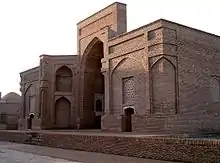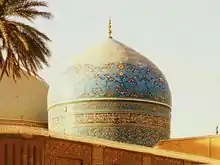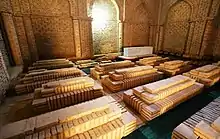Ali Akbar ibn Hasan ibn Ali ibn Muhammad
Sayyid Ali Akbar was a Sunni Muslim saint, and according to some historians of genealogy the second son of Imam Hasan al-Askari, the eleventh Imam in Shia Islam. He was also the brother of the twelfth Imam Muhammad al-Mahdi. His existence was hidden because of contemporary political conflicts with the political leadership of the Abbasids, reaching its peak at that time.[8][9][10]
Sultan ul Sadaat Jad-e-Hazrat Ishaan Sayyíd Ali Akbar al-Termizi | |
|---|---|
 Burial Place of Sayyid Ali in Termez | |
| Sultan of the Sayyids Grandpatriarch of The Hazrat Ishaans | |
| Born | 856–874 |
| Died | 922-926 Termez |
| Feast | Khwaja Digar, 3rd Rabi al Awwal |
| Patronage | The Sayyids[1] |
| Influences | Muhammad, Ali ibn Abi Talib, Abu Bakr, Jafar Sadiq, Muhammad al Mahdi |
| Influenced | Sayyid Abdul Qadir Gilani, Sayyid Moinuddin Hasan Sistani Chishti, The Hazrat Ishaans |
Tradition or genre | The Hazrat Ishaans |
Ali Akbar ibn Hasan ibn Ali ibn Muhammad | |
|---|---|
| Other names | (nickname), al-Amir, Abu Abdullah, al-Akbar, al-Asghar, al-Taqi, al-Muttaqi and others |
| Title | Sayyid al Sadat Sultan Sadat (leader of the sayyids)
Imamzadeh (son of the Imam) Najm Ahl al-Bayt Rasul Allah (Star of the Household of the Prophet of Allah) |
| Children | Sayyid Muhammad Mahmud Makki, Sayyid Ali al Asghar, Sayyid Uthman, Sayyid Musa, Sayyid Isa, Sayyid Hussain |
| Parent(s) | Hasan al-Askari bdisputed, Sayyid imam Muhammad al-Askari[2][3][4] [5][6][7] |
| Part of a series on |
| Sunni Islam |
|---|
 |
|
|
| Part of a series on Islam Shia Islam |
|---|
 |
|
|
| Part of a series on Islam Sufism |
|---|
 |
|
|
Sayyid Ali Akbar is venerated in Sunni and Shiite sufi Islam as the patriarch of various Sufi Saints.[11][12] According to other old genealogical sources Sultan Sadat Sayyid Ali Akbar was the second son of Sayyid imam Muhammad al-Askari who is considered the elder brother of imam Hasan al-Askari, and his descendants are called as Sadat Al-Baaj and this is confirmed by many genealogy scientists of the world.[13][14][15] [16][17][18][19] The genealogy scholar Dr.Sayyid Walid Al-Baaj has verified the lineage of descendants of Sayyid Ali bin Sayyid imam Muhammad al-Baaj and wrote a book about his descendants in 1999 and other books, that includes dozens of solid sources that many genealogists neglected, with many facts and old documents that talk about Sayyid Muhammad Al-Baaj and his al-Bukhari descendants and their honorable shrines[20]
Introduction
The genealogical records of some Middle Eastern families, especially from Persia and Khorasan, indicate that 11th imam had a second son, Sayyid Ali.[21][22] This is supported by the belief of various followers of Sufi saints, like the sunni saints Moinuddin Chishti and Bahauddin Naqshband, who were the founders of the Chishtiyya and Naqshbandiyya sufi orders and also the prominent Sufi Saint Khwaja Maudood Chishti.
In his Usul al-Kafi, al-Kulayni wrote, "All confirms the claim that Hasan al-Askari had more than one wife, in addition to slave girls, with whom he had relations" and, "when the caliph received news of Imam Hasan al-Askari's illness, he instructed his agents to keep a constant watch over the house of the Imam... he sent some of these midwives to examine the slave girls of the Imam to determine if they were pregnant. If a woman was found pregnant she was detained and imprisoned."[8][23][10]
Descendants
According to the earliest reports as cited below from official family tree documents and records, Imam Hasan al-Askari fathered seven children and was survived by six.[24][25] The names of his illustrious biological children were: Imam Muhammad al-Mahdi, Musa, Ja’far, Ibrahim, Fatima and ‘Ali, sometimes referred to as al-Akbar, al-Asghar, al-Taqi, al-Muttaqi or al-Amir, Abu Abdullah.[26][27][28][29][30][31] Еarly books on sayyid genealogy also mention that the descendants of Sayyid Ali ibn Sayyid imam Hassan al-Askari lived in the city of Sabzevar in shiite muslims Iran.[32][33] According to other old genealogical sources Sayyid Ali was the second son of Sayyid Imam Muhammad al Askari who is considered the elder brother of imam Hasan al-Askari, and his descendants are called as Sadat Al-Baaj[34][35][36] [37][38][39]
.svg.png.webp) Standard of the Hazrat Ishaans. Hazrat Ishaan I was a descendant of Sayyid Ali Akbar in the 22nd generation
Standard of the Hazrat Ishaans. Hazrat Ishaan I was a descendant of Sayyid Ali Akbar in the 22nd generation Sultan Saodat graves of Sayyid Ali Akbar and his relatives
Sultan Saodat graves of Sayyid Ali Akbar and his relatives Descendant of Sayyid Ali Akbar after 34 generations H.H. Prince Sayyid Raphael Dakik, Hazrat Ishaan XIV.
Descendant of Sayyid Ali Akbar after 34 generations H.H. Prince Sayyid Raphael Dakik, Hazrat Ishaan XIV.
Notable descendants of Sayyid Ali Akbar include the eleventh generation Sufi saints, Maudood Chishti and Bahauddin Naqshband.[40][41][42] One descendant after eighteen generations was Hazrat Ishaan. Maternal descendants of Sayyid Imam al-Askari and Hazrat Ishaan included the brothers, Sayyid Mir Jan, Sayyid Mahmud Agha and Sayyid Mir Fazlullah Agha, the Chief Justice of the Emirate of Afghanistan. And paternal descendant of Sayyid Imam Al-Askari Jamāl al-Dīn al-Afghānī also known as Sayyid Jamāl ad-Dīn Asadābādī and commonly known as Al-Afghani - a political activist and Islamic ideologist who travelled throughout the Muslim world during the late 19th century and Sayyid Mohammed Uthman al-Mirghani, known as "Al-Khatim", was the founder of the Khatmiyya sufi tariqa that has a following in Egypt, Sudan, Eritrea, Somalia and Ethiopia.
Annemarie Schimmel wrote, "Khwaja Mir Dard's family, like many nobles from Bukhara, led their pedigree back to Baha'uddin Naqshband, after whom the Naqshbandi order is named, and who was a descendant, in the eleventh generation of the eleventh Shia imam, Sayyid al-Hasan al-Askari."[23]
Burial place
The genealogy of Khwaja Samandar Muhammad ibn Baqi al-Termizi - the famous sheikh and poet, writer and scholar, author of "Dastur al Mulk" (Guide to Kings) (XVII сentury), goes back to Sultan Sadat - Al-Amir Sayyid Ali Akbar Termizi - in turn Al-Amir Sayyid Ali Akbar bin Sayyid imam Al-Askari, it is mentioned in his history book called "Dastur al Mulk". The 15th century famous poet, musicologist, scholar of language and other sciences Sahib Balkhi Sharifi wrote about the Sayyids of Termiz. His one of the poems begins with the name of Sultan Saadat (Sultan of Sayyids), i.e. the praise of Al-Amir Sayyid Ali Akbar al Termizi. Therefore, Sultan Saadat (Sodot) is the Sultan of Sayyids and the owner (historians suggest that Sayyid Ali Akbar bin Sayyid imam Muhammad Al-Askari's burial place is located in the main mausoleum Sultan Saodat memorial complex) "Sultan Saodat (Sadat)" Mausoleum (erected 9-15 centuries) in Termez city - and Sultan Sadat is Sayyid Ali Akbar al Termizi, which is also mentioned with the nickname (kunyat) Sayyid Abu Muhammad who presumably died at the end of the 9th century or early 10th century in Termez. Many tombs and nameless graves of more than a thousand sayyids are located in the "Sultan Saodat" memorial complex and its territory in Termez.[43][44][45][46][47]
List of notable descendants
- Bahauddin Naqshband
- Hazrat Ishaan
- Moinuddin Hadi Naqshband
- Sayyid Mir Jan
- Sayyid Mahmud Agha
- Sayyid Mir Fazlullah Agha
- H.E. Sayyid Sultan Masood Dakik
- Emir Sultan Shamsuddin Bukhari
- Ishan Imlo
- Ajall Shams al-Din Omar
- Tajuddin Muhammad Badruddin
- Pir Baba
- Qozi Sayyid Bahodirxon
- Shaal Pir Baba
- Maudood Chishti
- Ahmed Badawi
- Wali Kirani
- Khwaja Abdullah Chishti
- Ibrahim Yukpasi
- Salih al-Ja'fari
- Jamāl al-Dīn al-Afghānī
- Muhammad Mirgani
- Ali Mirgani
- Muhammad Usman Mirgani
- Mohammed Uthman al-Mirghani al-Khatim
- Ahmed al-Mirghani
- Shah Sayyid Nasruddin
See also
References
- Tazkare Khwanadane Hazrat Eshan(genealogy of the family of Hazrat Eshan)(by author and investigator:Muhammad Yasin Qasvari Naqshbandi company:Edara Talimat Naqshbandiyya Lahore)p. 65
- Sheikh Qumi, Muntahi al-Amal, 1379, chapter-3, p-20
- Hossein Madani, book "Tuhfat al-Azhar", Al-Tarat al-Maktub, chapter-1, pp-9-10
- Kharz ad-din, book "Markat al-Maarif", 1371, chapter-2, pp-242
- Badawi, Saba al-Jazeera, book Saba al-Dujail Information and Guidance Centre, p-10
- https://shajara.org/sulton-sodot-saodat-amir-sayyid-ali-akbar/ Sultan Sadat Sayyid Ali bin Sayyid Muhammad al-Baaj bin imam Ali al-Hadi
- Naqib al-Ashraf Ibn Abd al-Ahad Sherazi "Shajara-e-nasab", p-27-39, Islamic University, Association of Naqabats,2012
- Islamic Culture and the names of the Ahl al-Bait - Tazkare Khwanadane Hazrat Eshan ("Genealogy of the family of Hazrat Eshan") Edara Talimat Naqshbandiyya, Lahore p.63.
- Kulayni M. Y. and Sarwar M. (trans.) al-Kafi, chapter 124 "The Birth of Imam Abi Muhammad al-Hasan ibn 'Ali" p.705.
- "ZiaIslamic "Gulzar auliya"". Archived from the original on 2016-08-11.
- "Naqshbandiya shajarasi izidan". Archived from the original on 2017-08-03. Retrieved 2017-08-03.
- "Ҳазрат Хожа Баҳоуддин Нақшбанд". Archived from the original on 2017-08-03. Retrieved 2017-08-03.
- Sheikh Qumi, Muntahi al-Amal, 1379, chapter-3, p-20
- Hossein Madani, book "Tuhfat al-Azhar", Al-Tarat al-Maktub, chapter-1, pp-9-10
- Kharz ad-din, book "Markat al-Maarif", 1371, chapter-2, pp-242
- Badawi, Saba al-Jazeera, book Saba al-Dujail Information and Guidance Centre, p-10
- https://shajara.org/sulton-sodot-saodat-amir-sayyid-ali-akbar/ Sultan Sadat Sayyid Ali bin Sayyid Muhammad al-Baaj bin imam Ali al-Hadi
- Naqib al-Ashraf Ibn Abd al-Ahad Sherazi "Shajara-e-nasab", p-27-39, Islamic University, Association of Naqabats,2012
- https://shajara.org/sulton-sodot-saodat-amir-sayyid-ali-akbar/ About Sayyid Ali Akbar bin Sayyid Muhammad al-Baaj bin imam Ali al-Hadi
- http://www.alnssabon.com/t91117.html#post432618 Al-Baaj the offspring of Sayyid Muhammad Saba al-dujail ibn al-Imam Ali al-Hadi
- Kashani “Kitab al aqaid al iyman” page 259
- "Two hundred seventy-seven pirs" by Salim Bukhari
- Schimmel A. Pain and Grace: A Study of Two Mystical Writers of Eighteenth-Century Muslim India BRILL 1976, ISBN 9004047719
- Muhammed bin Yusuf Al Zarandi (d.720 hijrah) “Marij a’wusul ila ma’rifat fadlal” page 176
- Ibn Abi l-Thalj (d.322 hijrah) “Majmuat nafisa fi tarikh al-a’imma” pages 21-22
- Abul Hasan Ali bin Isa (d.1293 m.) “Kashf ul-Ghumma”
- Fahr Al-Razi Shafeiy (b.534 hijrah) “Al shajarat al mubaraka fi ansab” page 79
- Al Khasibi (b.890 hijrah) "Al-Hidaya al-kubra” page 328
- H.Hadjazada “Hidaqat ul Awliya”
- page 41 "النجف الأشرف) السيد محمد مهدي ابن السيد محمد اصفهاني الموسوي الكاظمي "دوائر المعارف في الأسماء الحسنى)
- "Shajara-e-nasab lineages of descendants of Imam Hasan al-Askari r.a.-Shajara.org". Retrieved 2020-06-29.
- Ali Al Arbali (d.693 h.) “Siraj al-Ansab” page 222
- https://shajara.org/1426-shajara-e-nasab-lineages-of-descendants-of-imam-hasan-al-askari/ Shajara-e-nasab lineages of descendants of Imam Hasan al-Askari r.a.
- Sheikh Qumi, Muntahi al-Amal, 1379, chapter-3, p-20
- Hossein Madani, book "Tuhfat al-Azhar", Al-Tarat al-Maktub, chapter-1, pp-9-10
- Kharz ad-din, book "Markat al-Maarif", 1371, chapter-2, pp-242
- Badawi, Saba al-Jazeera, book Saba al-Dujail Information and Guidance Centre, p-10
- Naqib al-Ashraf Ibn Abd al-Ahad Sherazi "Shajara-e-nasab", p-27-39, Islamic University, Association of Naqabats,2012
- https://shajara.org/sulton-sodot-saodat-amir-sayyid-ali-akbar/ About Sayyid Ali Akbar bin Sayyid Muhammad al-Baaj bin imam Ali al-Hadi
- Tariq, Author: Mujtaba. "Faizan-e-Umoor.com Hazrat Bahaauddin Naqshbandi (R. A.)". webcache.googleusercontent.com.
{{cite web}}:|first=has generic name (help) - "Род Бахауддина Накшбанда по линии матери происходит от хазрата Абу Бакра Сиддика (р.а.)". Studopedia.
- Naqshbandiya shajarasi izidan Archived 2017-08-03 at the Wayback Machine Shajara website.
- "Dastur al Mulk" (Guide to Kings) (XVII сentury) by Khwaja Samandar Muhammad ibn Baqi al-Termizi, translator professor of history Jabbor Esonov, "Sharq", Tashkent 2001, page 22
- "Durdonahoi Nasr" book, "Adib", Dushanbe 1985, page 375
- "Sayyidlar Shajarasi", "Islamic university", Tashkent 2017, page 14
- "Sulton Sodot Amir Sayyid Ali Akbar". Shajara.
- «Buyuk Termiziylar» (Буюк Термизийлар) book by Mirzo Kenjabek, “Uzbekistan National encyclopedias” 2017, page-267